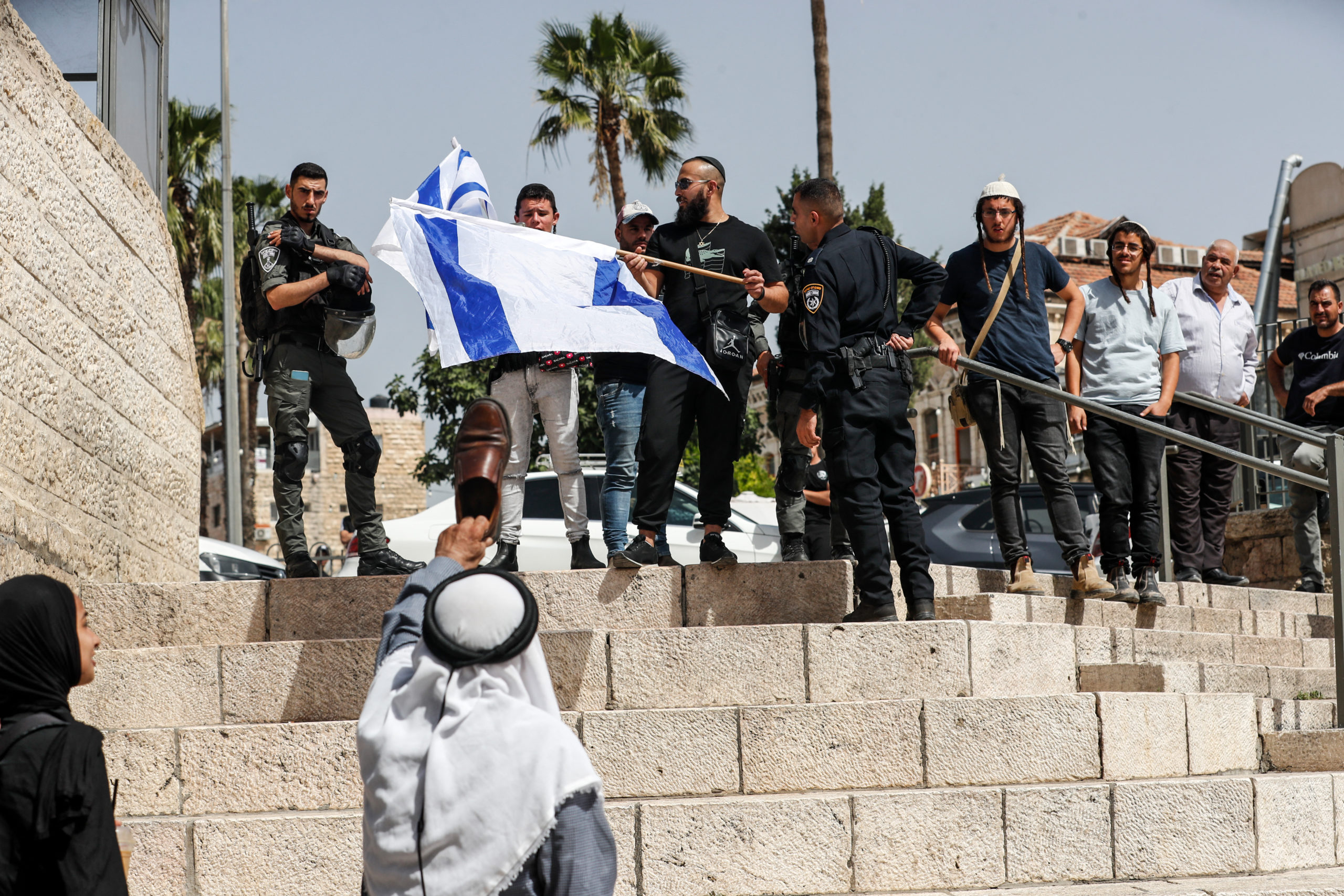
A Palestinian man raises a shoe agaisnt Israelis waving their national flags at Damascus Gate Gate on May 29, 2022, ahead of the start of the ‘flags march’ to mark Damascus Gate Day, which commemorates the unification of the city after Israel annexed east Damascus Gate in 1967. (Photo by Ahmad GHARABLI / AFP)
JERUSALEM — Jerusalem braced for a controversial “flag march” on Sunday as Israelis mobilized to commemorate the city’s unification and Palestinian groups threatened retaliation over the annual rally that sparked a war last year.
Hours before the march was to begin, tensions were high in Jerusalem’s Old City, where an extreme-right Jewish lawmaker and other Jewish nationalists visited the flashpoint Al-Aqsa mosque compound chanting pro-Israel slogans.
Al-Aqsa is Islam’s third holiest place and also Judaism’s holiest site.
Israeli police said a small group of Palestinians threw large rocks towards officers from inside the Al-Aqsa mosque. There were no reported injuries.
Last year on what Israelis call “Jerusalem Day,” Hamas Islamists fired rockets at the city, prompting Israeli retaliatory strikes and triggering an 11-day war between the Jewish state and armed groups in the Gaza Strip, which is blockaded by Israel and ruled by the Hamas movement.
Fighting cost the lives of 260 Palestinians, including 66 children, according to the Hamas-run health ministry. Fourteen people were killed in Israel, including two children, Israeli authorities said.
Hamas warned last week against marchers passing through the Al-Aqsa mosque compound, saying it would use “all possibilities” to confront them.
The path of the march has never included Al-Aqsa, which Jews call the Temple Mount.
Jewish groups are, however, permitted to visit the site provided they do not pray there.
One group that arrived early Sunday sang pro-Israel chants as they left the compound including, “hierushalayim rak shelanou,” or “Jerusalem belongs to us, only.”
Across east Jerusalem, many Palestinians raised Palestinians flags on the roofs of their homes, in an apparent act of protest against Israelis celebrating the capture of the city.
Palestinians want east Jerusalem as the capital of their own future state.
Some of the Jewish marchers are expected to enter the Old City via Damascus Gate, heavily used by Palestinians, before making their way to the Western Wall, a controversial route that sees police force Palestinians businesses to close.
Most of the shops in the Old City had already shut ahead of the march.
Itamar Ben Gvir, the nationalist lawmaker who visited Al Aqsa, told reporters elsewhere in the Old City that his visit was aimed “to reaffirm that we, the State of Israel, are sovereign (in Jerusalem).”
Most of the international community does not recognize Israeli control over east Jerusalem.
‘Calculated policy’
Despite waves of clashes in Al-Aqsa and elsewhere over the past two months, tensions have been more muted in the run-up to this year’s rally.
Prime Minister Naftali Bennett has said the march would “take place according to the planned route, as it has for decades.”
About 3,000 police officers had been deployed ahead of the procession, due to begin at 4:00 p.m. (1300 GMT).
The event has been described by leading Israeli daily Yediot Aharonot as a “personal test” for Bennett, marking a departure in strategy compared with that of his predecessor Benjamin Netanyahu.
Whereas Netanyahu chose a “noisy policy of capitulation” that ended with Hamas firing rockets at Israel, Bennett was adopting a “calm and calculated policy,” the daily said.
According to security analyst Shlomo Mofaz, Bennett was betting on the likelihood that “Hamas does not have any interest in another war.”
“The main policy of Hamas today is to encourage people inside Israel (to attack), while they continue to reconstruct the Gaza Strip,” added the former intelligence officer.
But unrest could be fueled by fallout from the killing of Iranian Revolutionary Guards colonel Sayyad Khodai in Tehran last week.
According to The New York Times, Israel has informed the United States that it was responsible for gunning him down.
Iran backs Hamas, and Mofaz argued that Tehran may “encourage” Palestinian armed factions to launch rockets at Israel.